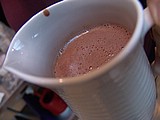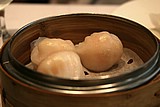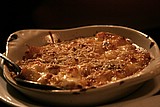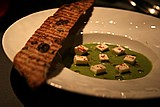Home |
Restaurants by City
|
Food Photography |
Archive | Philosophy |
![]()
Right now we are eating in Seattle, Washington.
|
Wednesday
2005
Permalink
|
Hot Chocolate, Round 2, tasted on February 5, 2005 — A few weeks ago we had our first blind taste test of various hot cocoas. It was surprising despite how many we tried, how few we liked. We agreed that we needed to do at least one more round of blind tasting and then proceed to a sort of "world championship" where we combined our favorite cocoas with our favorite recipes. Impatience got the best of us. We headed straight for squaring off our favorite recipes. And since not everyone prepared equally, some of the recipes weren't quite fine tuned enough. While we did have many entries, ultimately there were only three that mattered. These three were also the ones that were preferred the most by the tasters. Before we get into them, there is an issue of style. There are two (maybe three) archetypes that I know of for the perfect hot chocolate. And at a certain point you have to acknowledge these as they play such a key role in how you judge which hot chocolate you like best. The first is the classic hot chocolate. This is a sweet beverage. Sweet like milk chocolate. This is what most cocoas on the market target in terms of their flavor profile. Think hot chocolate milkshake. Very creamy. Lighter in color. Very sweet. This actually is the kind I prefer. It's not that I don't appreciate alternatives, it's just that this type of hot chocolate gives me the most pleasure. The next archetype is what I'll call the bittersweet hot chocolate. This is a darker hot chocolate. Maybe thicker. Not nearly as sweet. Not creamy per se, but likely silky. This is essentially drinkable chocolate. The new Chantico from Starbucks is a good example of it. People who eschew milk chocolate love this type of hot chocolate. The last is what i'll call spiced hot chocolate. This is basically a bittersweet hot cocoa with some added texture and flavor. It could be cinnamon, hot chilis, something complementary. Mexican hot chocolate typically lands in this spot from a flavor perspective. The texture is often a little rougher. I realize, my three archetype taxonomy is a bit of an oversimplification and there are all types of variations, but these are basically the three that I've encountered the most: Classic, Bittersweet, and Spiced. First, we only had representatives of the first two. Alex took a stab at making a spiced hot chocolate but he overdid the cinnamon and it really didn't meet the bar, so it's not worth discussing here. (Though there was some unfortunate imagery that Peyman decided to illustrate involving the texture of Alex' cocoa.) That said, we did have two excellent representatives of the classic and bittersweet hot chocolate archetypes. Ken delivered the classic and DebDu delivered the bittersweet. I made a bittersweet as well though I was intending to make a classic. The main thing we got from mine is a technique that I'll describe later. It's also important to note that the folks in the room were relatively divided in terms of which flavor profile they prefer. I'd say most prefer a bittersweet or spiced, while a couple of us like the classic. Of course, I really enjoy both as they're really essentially different beverages. Now DebDu was the perfect hostess (as usual) and prepared all sorts of accompaniments including two kinds of fresh marshmallows courtesy of WholeFoods, fresh doughnuts from Mark Bittman's cookbook, fresh Orange Madelines from Daniel Boulud's cookbook, and fresh whipped cream. We really couldn't have asked for more. But there was more. Peyman took the doughnut dough, wrapped it around some fresh banana and deep fried it. Mmmm... fresh banana doughnut. OK. There were two basic hot chocolates that rose above the rest. The first was Ken's. It followed the classic archetype. He started by melting a bunch of Scharffen Berger into milk. But it was way bitter for his taste so he added more and more sugar. When that didn't do the trick he started putting pieces of Hershey's milk chocolate wholesale into the mix. In the end, he ended up with a superlative Classic Sweet Hot Chocolate. The recipe is as follows:
DebDu provided an excellent rendition of the Bittersweet Hot Chocolate archetype. Here's her recipe:
Finally was my modest contribution to the tasting. To be honest, I was going for a classic sweet hot chocolate but ran into the same trouble as Ken. I couldn't add enough sugar or milk chocolate to sweeten it to my liking, but the fans of the bittersweet archetype liked it quite a bit. I think DebDu's recipe does a great job showing how to nail that, so there's no reason to include my recipe. I did do one small thing which I thought helped quite a bit. And to be clear, this is completely unoriginal. When I had my most perfect cup of hot chocolate ever it was at the Inn at Little Washington in Virginia. I got a teapot full of cocoa with a cup to pour it in. At the base of the cup was a small dollop of whipped cream flanked by a curl of white chocolate and a curl of milk chocolate. At first the cocoa covered those ingredients as I poured it in the cup. But after a three-count, the whipped cream rose to the top as if gasping for air. By this point the chocolate curls were almost completely melted but you could see their cream trails in the liquid. Bottom line, this little bit of alchemy and timing made for the best sip of hot chocolate I have ever had. Thick, creamy, unevenly sweet in a good way. Awesome. So without the finesse of chocolate curls (these were more like shavings) I tried the same thing during the tasting. You may ask why I used store bought aerosol whipped cream when fresh was available. I certainly love fresh whipped cream and it was available. But I remembered that the dollop at the Inn had a firmer consistency that I thought could only come with the help of some sort of gas injection. I thought I would compromise and buy some fancy organic aerosol whipped cream at the Wholefoods. But instead of being embarrassed I should have just held my head high and used my personal favorite - Reddiwip (I confess I had no idea how to spell it until I looked them up on the web). Yep, I love Reddiwip. I find it delicious. I often eat it straight out of my palm or just spray it straight into my mouth. It's fantastic. Peyman who I think just doesn't like aerosol whip in general hated the taste of the one I bought. And I didn't like it as much as I would have since it wasn't my favorite Reddiwip. That said, despite the whipped cream mishap, it was clear that the whipped cream with shaved white and milk chocolate had it's desired effect. The "Pre-Whipping" of the hot cocoa was a hit in my opinion. Even with my not super, but not bad hot chocolate it just elevated the cup to a new level of enjoyment. Especially for that first 1-2 minutes of drinking. Timing is key as you need to basically hand the person the cup right before you pour the hot chocolate into it. But still it was clearly worth it. To recap: pick which archetype you like, the classic sweet or the bittersweet. Choose the appropriate recipe from above. Fill the target cups with whipped cream (fresh or Reddiwip as you see fit) as well as a variety of chocolate shavings (I prefer milk and white) and pour the hot chocolate into the cups seconds before your friends, family, and/or welcome/unwelcome guests are ready to drink. I promise there will be smiles all around. And of course, for every 10 degrees the weather is below 40 farenheit, the enjoyment of the cocoa increases exponentially. That's a scientific fact!
|
|||
Our Sponsors
Free Car Listings – Hot Tubs – Stools – Saunas – Bar Stools - Calendar and Event Schedules - Food Events and Calendars - Wine Events and Calendars - Digital Photography Resources - Software for Advertisers - Jewish Gifts and Judaica - Howard Stern Podcast - ponytailed blogger Jonathan Schwartz

Browse tastingmenu
Home |
Restaurants by City X |
Food Photography |
Archive | Philosophy |
![]()
Free eBooks: All About Apples
| Autumn Omakase
More:
Discussion |
Cool Food T-Shirts |
Ingredients
| Markets |
Recipes
Search |
Blog FAQ |
Other
Blogs
Best of tastingmenu
|
City View
Entry: July 6, 2006 |
Blue Plate
Entry: June 19, 2006 |
L'Atelier de Joël Robuchon
Entry: July 18, 2006 |
Browse by City
Boston | Chicago | Houston | Las Vegas | Los Angeles | Maui | New York | Philadelphia | Portland | San Francisco | Seattle | Toronto | Utah | Vancouver | Washington D.C.
Bangkok | Beijing | Hong Kong | Seoul | Tokyo
Amsterdam | Berlin | Italy | London | Madrid | Paris | Vienna
Browse by Month
2006
2005
2004
2003
2002
2001
Comments, questions, or feedback:
info / at / tastingmenu / dot / com
All pages Copyright (c) 2001-2006 tastingmenu.com
Last modified 01/30/07.




